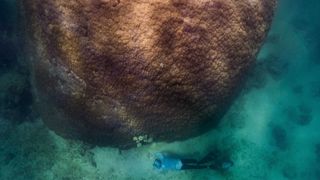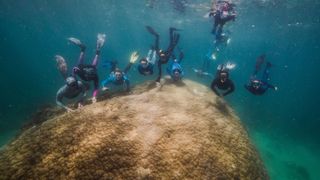400-year-old 'Muga dhambi' is one of the largest and oldest corals in the Great Barrier Reef
It predates the colonization of Australia.

Australian scientists have discovered one of the largest and oldest coral colonies in the Great Barrier Reef, which is the largest coral reef system on Earth.
The massive coral belongs to the genus Porites and measures 34 feet (10.4 meters) wide and 17.4 feet (5.3 m) tall, making it the widest and sixth-tallest coral in the Great Barrier Reef. Snorkelers found the record-breaking coral off the coast of Goolboodi, part of the Palm Island Group in Queensland, Australia, and they named it "Muga dhambi" — meaning "big coral" in the language of the Manbarra people, who are the Indigenous people of Palm Islands.
The researchers found that the massive coral has been around for between 421 and 438 years, meaning that it predates the colonization of Australia. The colony has survived centuries of exposure to invasive species, coral bleaching events and low tides, as well as around 80 major cyclones, the researchers said.
Related: Sea science: 7 bizarre facts about the ocean
"The structure is probably one of the oldest on the Great Barrier Reef," Nathan Cook, a marine scientist at Reef Ecologic, an NGO in Australia specializing in corals, told Live Science.

Corals are colonial animals that get a majority of their energy from a symbiotic relationship with photosynthetic algae called Zooxanthellae. The colony is connected by a skeleton made out of calcium carbonate from the surrounding seawater, which slowly grows over time.
Muga dhambi's incredible girth is the result of its hard skeleton, which requires extra stability in the water, whereas more flexible soft corals require a less solid foundation
Sign up for the Live Science daily newsletter now
Get the world’s most fascinating discoveries delivered straight to your inbox.
"These massive colonies grow in a hemispherical shape, likely prioritising width over height for stability," Cook said. "It is difficult for any hard coral species to grow really tall without breaking."
Other Porites corals in the Pacific grew even larger than Muga dhambi; in American Samoa, one coral colony was recorded at an astonishing 56.8 feet (17 m) wide and 39.4 feet (12 m) tall. That reef is outside of the Great Barrier Reef, but it does suggest the possibility of finding even larger Porites colonies in the Great Barrier Reef, Cook said.
"There are many unexplored corners of the Great Barrier Reef," Cook said. "It is possible there are larger coral colonies waiting to be documented by intrepid citizen scientists."
Ancient colonies like Muga dhambi provide scientists with a rare opportunity to learn more about the reef conditions as the corals grow.
"Large coral colonies are like historical repositories holding secrets within their calcium carbonate skeletons," Cook said. Similar to taking cores of Antarctic ice sheets to see how atmospheric conditions have changed over time, it is possible to take samples of coral skeletons to see how ocean conditions on the Great Barrier Reef have changed, he added.
Unfortunately, this is only likely to confirm what scientists already know — that ocean conditions are becoming much more inhospitable to corals.
"Corals are sensitive to environmental changes, particularly rising sea temperature," Cook said. "There has been a decline of 50% of coral cover on the Great Barrier Reef over the past 30 years," he added, making them the "canaries in the coal mine" for climate change.
Researchers remain hopeful that even if a majority of coral cover is lost, resilient colonies like Muga dhambi could continue to survive in the future. The colony is in very good health with 70% consisting of live coral and the rest being covered with sponge and non-symbiotic algae.
"Due to the increasing severity and intensity of disturbances to ecosystems worldwide, corals like this are becoming increasingly rare," Cook said. "As optimists, we hope that Muga dhambi will survive for many more years, but it will require a big change in human impacts."
The study was published online Aug. 19 in the journal Scientific Reports.
Originally published on Live Science.

Harry is a U.K.-based senior staff writer at Live Science. He studied marine biology at the University of Exeter before training to become a journalist. He covers a wide range of topics including space exploration, planetary science, space weather, climate change, animal behavior and paleontology. His recent work on the solar maximum won "best space submission" at the 2024 Aerospace Media Awards and was shortlisted in the "top scoop" category at the NCTJ Awards for Excellence in 2023. He also writes Live Science's weekly Earth from space series.










